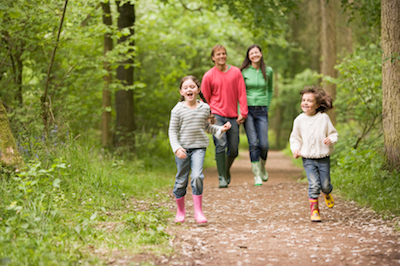The Surprising Amount Of Green Exercise Needed For A Better Mood
By Dan Peterson, TeamSnap's Sports Science Expert.
One of the worst parts of winter is logging all of those miles on a treadmill under fluorescent lights with a fan blowing stale air at you. For kids, it’s the dreaded indoor gym class when all they want to do is get outside into the lush, sunshine-filled world. There’s something about being outside that lifts the spirits, making strenuous exercise not seem so bad. Several recent research studies have confirmed that fresh air makes us happier and an estimate of the shortest amount of outdoor time needed to change our mood is surprising.
In a review of 11 different studies involving 833 adults, UK researchers found that exercising outside provided more revitalization, energy and positive interactions, while they noticed less tension, confusion, anger and depression. Even better, the test volunteers said they enjoyed their workouts so much that they would be more likely to repeat it.
"The hypothesis that there are added beneficial effects to be gained from exercising in the natural environment is very appealing and has generated considerable interest,” said Dr. Jo Thompson-Coon, research fellow at the Peninsula College of Medicine and Dentistry. “By using the data currently available to us we have added strength to the link between mental and physical well-being and outdoor exercise, but further research and longer, tailor-made and focused trials are needed to better understand this link."
This healthy link to the environment combined with a desire to preserve it has created a unique program throughout England known as the Green Gym. The goal is to get people outdoors working on clean up and restoration projects that get the blood pumping, muscles moving and fix a little corner of the world in the process. The water-based sibling program, Blue Gym, accomplishes the same thing for rivers, ponds and lakes.
 "Some 75% of the European population now live in urban environments, so that increasing efforts need to be made to reconnect people with nature via programmes such as the Green Gym and Blue Gym,” said Professor Michael Depledge, Chair of Environment and Human Health at the European Centre for the Environment and Human Health (ECEHH). “Our research, which brings together data from a wide variety of sources, adds significant weight to the case for spending more time in the natural environment as members of the public and their clinicians fight to counteract the negative outcomes of modern living, such as obesity and depression.”
"Some 75% of the European population now live in urban environments, so that increasing efforts need to be made to reconnect people with nature via programmes such as the Green Gym and Blue Gym,” said Professor Michael Depledge, Chair of Environment and Human Health at the European Centre for the Environment and Human Health (ECEHH). “Our research, which brings together data from a wide variety of sources, adds significant weight to the case for spending more time in the natural environment as members of the public and their clinicians fight to counteract the negative outcomes of modern living, such as obesity and depression.”
Their research was published in Environmental Science and Technology.
Sometimes just the thought of a green environment while exercising may be enough to get the added health benefits. In a study published this month, 9 and 10 year old kids hopped on an exercise bike indoors. Half the group watched a video of a trip through a forest synced with their bike ride, while the other half saw nothing but the inside of the lab.
Sure enough, the kids who took a simulated trek through the tree-lined path had a significantly lower post-exercise blood pressure reading than the control group.
"Hypertension is a chronic health problem across the world, so given the results we've seen in our study it's crucial that we continue to try to understand the role physical activity and -- in particular -- green exercise plays in blood pressure,” said Dr Michael Duncan, lead author of the study and associate head of the Department of Applied Sciences and Health at Coventry University. "If there is indeed a correlation between viewing scenes of nature and a lower blood pressure post exercise, as indicated by our data, it could have very positive implications in encouraging public health practitioners to prescribe outdoor exercise to reduce health risk."
between viewing scenes of nature and a lower blood pressure post exercise, as indicated by our data, it could have very positive implications in encouraging public health practitioners to prescribe outdoor exercise to reduce health risk."
So, how much green time is required before its Zen effect kicks in? To find out, Dr. Jules Pretty of the University of Essex reviewed 10 studies covering 1,252 people engaged in walking, gardening, cycling, fishing, boating, horseback riding and farming.
"For the first time in the scientific literature, we have been able to show dose-response relationships for the positive effects of nature on human mental health," Pretty said.
The biggest increase in self-esteem occurred after just 5 minutes of outside activities! If five minutes can start to make a difference in our moods, imagine what an hour of running, hiking, or even working on a conservation clean-up project would do for our attitudes.
NEW! Free Sports Organization Resources
All of TeamSnap's ebooks, articles, and stories in one place. Access Now
Similar Articles:

The Surprising Amount Of Green Exercise Needed For A Better Mood
By Dan Peterson, TeamSnap's Sports Science Expert. One…
Read More

Pre-Game Pep Talk's Influence on Performance
By Dan Peterson, TeamSnap's Sports Science Expert …
Read More

Pete Rose and the Link Between Competitive Athletes and Gambling
By Dan Peterson, TeamSnap's Sports Science Expert …
Read More
